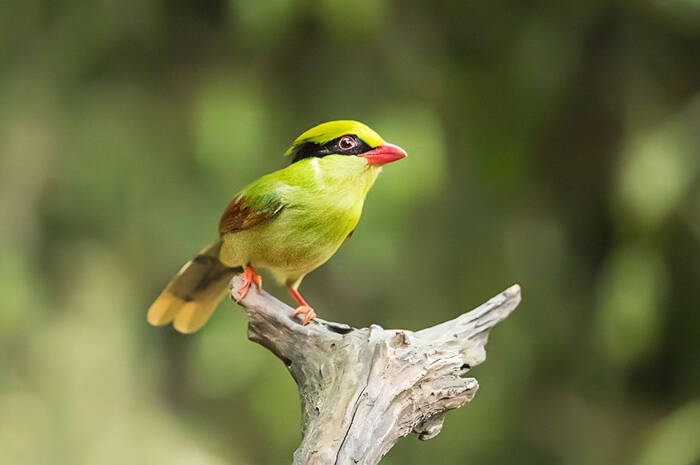Cissa hypoleuca
IUCN
LCBasic Information
Scientific classification
- name:Cissa hypoleuca
- Scientific Name:Cissa hypoleuca,Yellow-breasted Magpie,Oriental green magpie, Indochinese green magpie, Indochinese green blue magpie
- Outline:Songbird
- Family:Passeriformes Corvidae G.Magpie
Vital signs
- length:30-33cm
- Weight:118-155g
- lifetime:No verification information
Feature
The sound is varied and loud
Distribution and Habitat
Distributed in China, Lao People's Democratic Republic, Thailand, Vietnam.
Origin uncertain: Cambodia.
It mainly lives in primary and secondary forests in mountains, in broad-leaved forests at an altitude of about 2,000 meters.
Appearance
The forehead, top of the head, extended occipital feathers and cheeks of the male adult yellow-breasted green magpie are green; a broad black ring is formed on the side of the head from the eyes through the eyes to the neck; the shoulders and upper body are green; the tail feathers are green The feather tips are light gray, and the outer tail feathers have black secondary spots; the wings are dark brown or chestnut red except for the light green minor coverts, and the inner secondary flight feathers have wide bright green tips. The lower body is light yellow to bright yellow, and the throat is greener.
The body color of the female adult bird is similar to that of the male bird, but the feathers are lighter and the body is slightly smaller.
The mouth, tarsometatarsus and claws are all orange-yellow.
Size measurements: body weight ♂135-155g, ♀118-130g; body length ♂320-336mm, ♀306-320mm; bill peak ♂29-35mm, ♀29-32mm; wings ♂138-148mm , ♀135-139 mm; tail ♂153-165 mm, ♀138-146 mm;
Details
Yellow-breasted Magpie, also known as Yellow-breasted Magpie, has 5 subspecies.

Yellow-breasted Magpie moves in pairs or small groups, often making loud calls but rarely appearing. It preys on insects in the lower levels of the forest. It is a mixed species, and its food composition changes with the season and environment. In summer, it mainly feeds on insects and other animal foods, while in other seasons, it mainly feeds on plant fruits and seeds. Common food species include locusts, grasshoppers, beetles, weevils, beetles, katydids, cutworms, pine caterpillars, stink bugs, ants, flies, snakes and other Lepidoptera, Coleoptera, Orthoptera, Hymenoptera and other insects and larvae. In addition, it also eats chicks and bird eggs. Plant food mainly includes fruits and seeds of trees and shrubs, and also eats crops such as corn, sorghum, soybeans, peas, and wheat.
The sound of the yellow-breasted green magpie is varied, loud, mournful, piercing screams "peu-peu-peu" followed by a rough "chuk"; there are also high-pitched chirping sounds that sound like scolding.
The breeding season of the Yellow-breasted Green Magpie is from April to July. Usually, the nest is built on a tree or a tall shrub, and also on a bamboo bush. The nest is cup-shaped, and the outer layer is mainly composed of dead branches, dead grass stems, grass leaves, roots, bamboo leaves and other materials. The inner layer is padded with fine grass roots and soil, and the inner layer is padded with soft materials such as hemp, fiber, grass roots, moss, animal hair and feathers. The nest is 7-15 meters above the ground, and the size of the nest is 30.2 mm × 22.9 mm. The nesting time is 20-30 days. After the nest is built, it will start to lay eggs, with 3-7 eggs per nest, mostly 4-5 eggs, and 1 egg per day, mostly laid in the early morning. The eggs are grayish white, white or light red, with brown or black spots, and the eggs are oval or oblong. After all the eggs are laid, they begin to incubate. The female bird incubates the eggs, and the incubation period is 17±1 days. The chicks are late-maturing. The newly hatched chicks are naked and pink. The male and female parents raise the chicks together. The chicks can leave the nest in about 30 days.
Listed in the "Red List of Endangered Species of the World Conservation Union" (IUCN) 2016 ver 3.1-Least Concern (LC).
Listed in the second level of China's "National Key Protected Wildlife List" (February 5, 2021).
Protect wild animals and stop eating game.
Maintaining ecological balance is everyone's responsibility!








